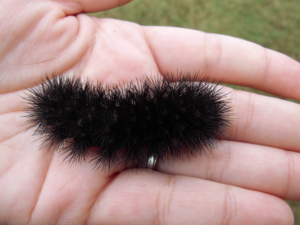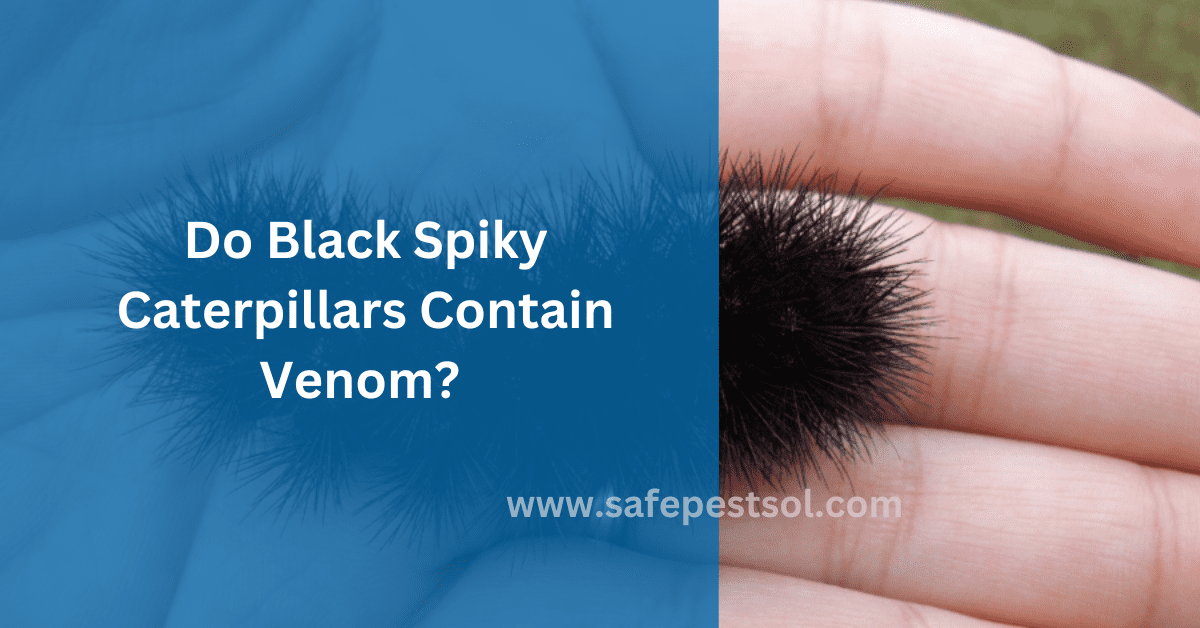Are Black Spiky Caterpillars Poisonous?
Despite the strange look of black spiky caterpillars, many often misunderstand their existence. They may resemble danger due to the striking patterns and fuzzy black spines, but do they really? Many people wonder if touching these insects causes irritation and poisoning.
Let us help you understand black spiky caterpillars, some of their most common types, and whether they are dangerous. This blog will also explain the importance of their presence in our environment.

What Black Spiky Caterpillar Actually Is
Black spiky caterpillars are also called eyed tiger moth caterpillars. They are fuzzy black but with red or orange bands on them. They curl into a ball if threatened so that the red marks become easier for predators to see. This action is purely their defensive mechanism and they don’t cause any harm.
These caterpillars sometimes squirt a yellowish liquid when touched, which is another defense mechanism. While the liquid is non-toxic, it is still best to wash up your hands after handling them.
Black spiky caterpillars have several molting stages before becoming adult-size. The smaller caterpillars are typically smaller and have fewer color bands. They eventually become moths. Some moth species are quite striking in appearance due to white wings adorned with black spots on them, like the giant leopard moth.
Common Types of Black Spiky Caterpillars
| Name | Identification | Habits |
| Peacock | Spiny; black with white spots | European species feed on nettles |
| Giant leopard moth | Strong spines, red bands | Rolls up when threatened |
| Mourning cloak | Spines with red spots along the back | Feeds on elm |
| Pipevine swallowtail | Fleshy tentacles with some orange | Feeds on Aristolochia, possibly toxic |
| Black cutworm | Flat black with few markings | Active at night; found in soil |
| Garden tiger moth | Thick long hair, some white and orange | Feeds on low plants |
| Azalea caterpillar | Speckled black with red and orange | Feeds in groups on azalea leaves |
| Banded woolly bear | Black with red on each end | Wanders in late summer for cocoon site |
Are Black Spiky Caterpillars Poisonous?
As terrible as black spiky caterpillars look, they are not poisonous or dangerous to humans. Most people think they can sting them because of the spines. In reality, they don’t. They are not stinging caterpillars.
They are even found in several colors, which can make a few species almost identical to species that really sting. However, the black, spiky caterpillars do not sting and cause no actual harm.
Do Black Spiky Caterpillars Help the Environment?
Black spiky caterpillars are similar to other insects which adds something to the environment in many ways. They consume nectar from flowers when they become moths. Caterpillars, particularly this species, are crucial food sources for birds, bats, and other predators.
While serving many benefits, black spiky caterpillars bring their own drawbacks. Being pests in the garden, they may cause trouble. The larvae may damage crops and ornament plans because they consume plant foliage. The range of damage mainly depends on the size and number of their population and how much they have consumed plants.
What is the Lifecycle of Black Spiky Caterpillars?
There are four primary life stages for a black spiky caterpillar:
- Egg – Adult moths lay up to 1,200 eggs on host plants.
- Larva (Caterpillar Stage) – Several moults increase in size at each stage. It may take one to one and a half months, depending on food availability and environmental conditions.
- Pupa – The caterpillar forms a cocoon, usually in leaf litter or soil. The pupal stage lasts about two weeks.
- Adult Moth – It then returns to feed on nectar and mate to continue its life cycle.
Black spiky caterpillars go into a form of hibernation called diapause when the weather becomes cold. It helps them slow their growth till things warm up.
Can Black Spiky Caterpillars Predict Winter? Myth or Fact?
Many myths are being told about the black spiky caterpillar, especially the banded woolly bear. Such a caterpillar is said to predict the harshness of the winter. As per the folklore, a brown band of a caterpillar signifies the winter. If the band is broader, upcoming winter would be harsh, and milder if it is narrower.
This is not a scientific fact since research suggests that caterpillar colors are determined by age, diet, and environment rather than weather conditions. Although an interesting concept, this remains a myth rather than a confirmed phenomenon.
What to Do If a Black Spiky Caterpillar Bites You?
As black spiky caterpillars do not sting, some of the species may have bristle-like protrusions that cause minor irritation whenever touched. If you get a cut or feel a pang by touching them, do this:
- Use a stick, pen, or credit card to gently take out the caterpillar with your bare hands.
- Check your skin for any remaining hairs or spines and take them out using tweezers or tape.
- Wash the affected area with soap and water to avoid irritation.
- Watch out for allergic reactions, though severe reactions rarely occur. Consult a doctor if swelling or discomfort continues.
Best Ways to Get Rid of Caterpillars
If the black spiky caterpillars are damaging your plants, use the following toxic-free removal techniques:
- Hand-picking – Remove them manually and relocate them to another place away from your garden.
- Neem oil spray – Acts as a natural discouragement that keeps caterpillars from feeding on leaves.
- Bring natural predators – Species like birds, wasps and other insects will help you control caterpillars, as they are natural predators.
- Row covers – Avoid caterpillars from laying eggs by using mesh covers.
The last resort would be chemical pesticides because they can destroy beneficial insects and disrupt the ecosystem.
Final Thoughts
Although the black spiky caterpillars may seem intimidating, they are harmless. In fact, they play a huge role in nature. However, they may cause harm to your plants, but they are contributing to biodiversity by becoming moths later, becoming a part of the food chain.
No matter if you consider them great insects or ordinary garden pests, their purpose explains why they should be appreciated as a part of our environment.
FAQs
1.Do black spiky caterpillars contain poison?
No, they are not toxic or poisonous to human beings. A few may cause slight dermal irritation but pose no deadly or severe danger.
2.Do black spiky caterpillars bite or sting?
No, they do not bite or sting. However, they may cause slight irritation from their hard bristles upon touching them.
3.What if I touch a black spiky caterpillar?
Most of the black spiky caterpillars are harmless, though one must wash his hands afterwards in case if feels irritation.
Safe Pest Sol – The Best Way to Get Rid of Caterpillars!
We are an expert pest control team, always ready to help you get rid of any pest infestation. Just call us right now and book our services!

